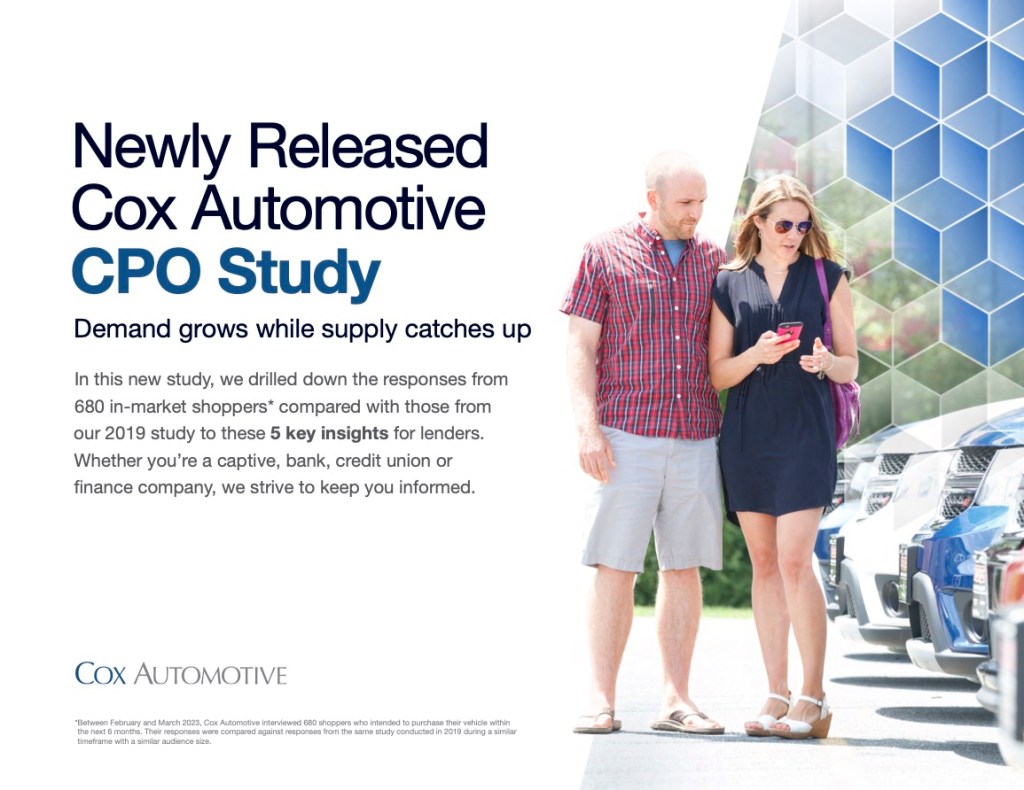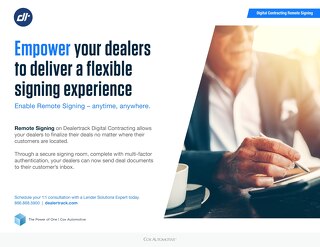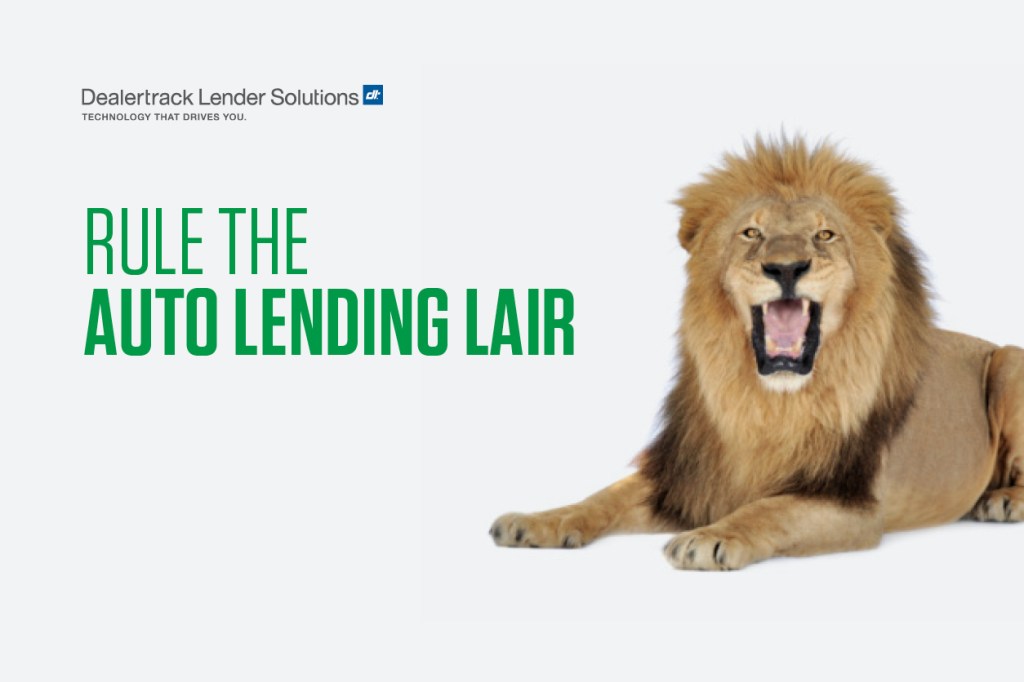2023 Finance Study Takeaways



Whether you’re a captive, bank, credit union or finance company, this new study summary will help you better understand the trends shaping buyer sentiment, originations, financing and more.

Allow your dealers to finalize their deals no matter where their customers are located.

As of the first quarter of 2020, there were 116.46 million car loans in the U.S. In any market conditions, lenders require the right data and insights to effectively manage their loan portfolios. With the current turbulent circumstances affecting auto retailing, jobless rates, consumer debt and nearly every other aspect of the economy, it’s more vital than ever for lenders to ensure they are balancing and protecting their collateral.
Let’s explore some obvious and not-so-obvious areas of risk lenders commonly face over the life of a loan, along with best practices for handling them.
Routine portfolio management: Is it really that routine?
The average term of an auto loan in 2019 was 61-84 months according to Experian data. Once the contract is signed and the consumer drives off with the vehicle, the dealer’s part of the transaction is over, but the lender’s work continues.
We’ll talk later about some of the worst-case scenarios that can crop up during those long loan terms, but let’s start with loans that are quietly paid off on schedule by the consumer.
Even in this “good” scenario, it’s important for a lender to access reliable valuations data to help them securitize the portfolio, assess collateral depreciation and/or estimate its liquidation value at auction. Digital valuation tools can help lenders evaluate which collateral they should maintain to maximize their ROI throughout the term of the loan.
There are also title considerations for every loan, which can require juggling different processes for paper, electronic and owner-held titles depending on the state. This is another area where technology can help streamline the process.
Flat tires and fender-benders: No big deal, right? Well, that depends…
According to Dealertrack data, consumers buy an average of two aftermarket protection products with each vehicle purchased. The dealership does the work of submitting the contract and payment to the aftermarket provider, but it’s advisable for lenders to put a process in place to verify that the aftermarket contracts they fund are actually in effect.
Having the assurance that the vehicle you financed will have minor damage covered by the purchased aftermarket service not only makes you a good steward of protecting the consumer, but of your collateral and your own bottom line, should the consumer decide to trade the car in, and may be owed a refund on the aftermarket contract cancellations – an estimated $4B+ business each year, according to Dealertrack and F&I Express transaction data. We’ll talk more about this in the next scenario.
Damaged beyond reasonable repair: The pain of total loss…
When a vehicle gets damaged severely enough to be totaled, the workload for the lender intensifies. There are two key areas where technology solutions can help comply with state regulations, protect dealer relationships and consumers, and ensure reliable loss calculations.
Insurance and Salvage Negotiations – In cases where the outstanding loan balance is higher than a vehicle’s market value, it can take 2-3 months or more of back-and-forth including phone calls and redlines on letters of guarantee to determine how effectively a lender will be able to preserve their investment. It’s helpful for lenders to partner with solution providers that can help them stay apprised of their portfolio value and establish an efficient total loss payoff process.
Aftermarket Cancellations – Aftermarket cancellations play an important role in calculating the valuation for insurance negotiations because they affect the deficiency balance on the loan. They are also an important compliance step in the 46 states that currently make lenders legally responsible for timely and accurate aftermarket refunds and loan reconciliation. This is no small amount of money: 2019 cancellation transaction data from F&I Express and payoff quote data from Dealertrack suggest that aftermarket cancellations could potentially reach $4 billion a year or more.*
To repo or not to repo?
Industry statistics show that more than 2 million vehicles are repossessed every year for lapsed loan payments. Although repossession is not uncommon, it is a time-consuming process for numerous lender teams including loan service, collections and titling.
Before the repossession process even begins, having that reliable valuation data is critical to determining whether the value of the vehicle minus the loan balance can offset the expense of taking the vehicle back, reconditioning it, and selling it at auction or retail. Again, aftermarket cancellations are part of that valuation as well because they may help the lender recoup some of the deficiency balance on the loan.
According to 2019/2020 statistics, for every 2.4 cars sold, one existing vehicle on the road will be repossessed each year. That means it’s important for lenders to have the tools in place to make the process as efficient and cost-effective as possible.
Protecting your entire loan portfolio
There are technology solutions available to help lenders guide risk mitigation strategy for every part of their auto loan portfolio lifecycle including aftermarket verifications, title management, valuations, aftermarket cancellations due to payoff, total loss or repossession – and everything in between.
To learn more about mitigating portfolio risk, download our latest insights report.

Still wondering if you should be using eContracting for your auto loan originations? Let’s examine some of the reasons lending institutions should already be using eContracting or digital contracting.
1. eContracting is the new standard
It’s no longer a matter of if you should be using eContracting: the industry has already hit the tipping point and it’s now a matter of when you’ll start trying to catch up with the early adopters. Lenders who use eContracting are already funding 2-3 days faster on every transaction and building dealer loyalty in the process. Which leads us to point #2…
2. Your dealers want eContracting
Dealers are adopting eContracting in record numbers and demanding that their lenders participate. In their efforts to counter margin pressure, dealerships are shifting their workflows to gain productivity and efficiency. They also value fast funding — and Cox Automotive dealer/lender research shows that it’s one of the top three reasons dealers choose a lender partner. Finally, there is customer demand for a faster and more efficient purchase process, which can be facilitated by eContracting and electronic signing.
As every lender knows, partnerships with dealers are measured by service, so helping your dealers improve their workflow and funding them as quickly as possible is exactly the kind of service that can help improve your relationships.
3. The paperless deal offers operational efficiencies
The industry is headed toward the paperless deal to improve efficiency and reduce overhead costs for dealers and lenders alike. eContracting can reduce days in transit from the dealer to the lender from an average of five days to just one, and its built-in accuracy features can help reduce returned contracts and re-contracting by 80%.
The paperless deal saves dealers from having to reprint forms that change, eliminates shipping costs, and allows for digital document storage that frees up office space while helping to keep forms available in case of audit.
Taking another evolutionary step further, going paperless leads to enabling lights-out funding. With eContracting doing the validations and eContracting producing electronic documents, the next opportunity is to use technology to auto-fund contracts the way loans are auto-decisioned today.
Want to learn all the reasons why now is the time to start eContracting with dealers? Join us at AFSA on Thursday, February 13th where Andy Mayers takes the stage to discuss Digital Contracting during the Technology Advancements program—or stop by booth #104.

Lose the paper, and gain the business – digital contracting optimizes review and approval for funding as fast as the same day.

The old saying is that too many cooks spoil the broth. But when it comes to finding ways for lenders to handle large volumes of paper contracts until the auto industry fully transitions to electronic contracting, some extra help in the “kitchen” can make all the difference.
Taking the measure of the industry
Today, the auto retail industry is rapidly ramping up technology to meet the consumer expectations. Research has shown that 83% of consumers want to complete at least one purchase step online, yet nearly 90% still prefer to sign their final documents at the dealership.
That leaves lenders with a small number of dealers submitting contracts digitally, while the majority still mail in paper contracts. This can cause lenders to develop two divergent sets of processes that can increase the time it takes to process and fund auto loans.
This situation creates some dilemmas for lenders. One is that any efforts to create parallel processes to maximize speed and efficiency for both electronic and paper contract processes will likely become unnecessary within the next few years as consumers and dealers become more open to fully digital deals.
Another consideration is that all dealers want fast funding, regardless of whether they submit contracts electronically or on paper.
The recipe for success
Efficient paper contract processing and funding requires carefully weighed portions of accuracy and compliance at every level of workload.
The ingredients include:
The right partnership can provide all of those and more to help you provide a five-star experience for all your dealer partners.
Want to learn more? Connect with a Dealertrack Lender Solutions expert to discuss the best options for your business.

Auto lending is a valuable service for dealerships, with 85% of new cars purchased in 2018 financed rather than purchased outright. Dealers require fast funding to stay cash flow positive, so it’s important for lenders to strive for the quickest possible turnaround.
Every day, lenders must perfect the juggling act of staying competitive through speedy funding while still focusing on accuracy and compliance. But if you think of day-in-and-day-out contract processing as juggling sandbags, peak loan volume months are more like juggling torches.
That’s when the combination of digital and paper contract processing can strain the resources of even the most efficient lending operation and its staff. When you’re facing a significant increase in volume, it become harder than ever to maintain compliance with state and federal regulations while trying to speed up data entry without introducing errors.
Finding the balance between accuracy and speed
Before you can maximize funding speed, it’s important to figure out how and where your processes might be slowing things down. When it comes to processing paper contracts, most lenders find that manual data entry, validation and storage of documents are where things get off-kilter.
Working with a reliable technology partner to handle these tasks is a cost-effective way to increase your speed to fund without sacrificing accuracy or compliance.
Want to learn how? Download our eGuide.

What’s the number one way for a lender to add value for their dealer partners? Faster funding.
In today’s automotive marketplace where profit margins are crunched and sales have plateaued, auto dealers are looking for ways to free up cash flow and preserve their bottom line. Naturally, they prefer to work with lender partners who can be part of the solution.
Building stronger dealer relationships
According to recent industry figures, around 85% of all automobile purchases are financed. Dealers rely on the cash flow from these deals to keep their inventory numbers up so they can continue selling cars. Lender partners that are fastest to fund help keep this cash from “floating” on their dealers’ books and free it up to keep the dealership running smoothly.
Supporting both paths: paper and digital
eContracting is slowly gaining ground with more progressive dealers, but the majority of dealers still rely on paper contracts and must overnight their funding packages to lenders. Lenders that can process contracts and fund dealers the very next day – regardless whether the contracts are digital or paper – have a decided advantage.
There are several common obstacles that make it difficult for lenders to achieve consistent next-day funding speed with paper contracts, including speed of data entry, resource gaps during peak volume times, and the inability to increase speed without comprising accuracy.
Available technology solutions can address all of these obstacles and allow lenders to confidently provide consistent funding speed for their dealer partners.
Ready to optimize your paper contracting operations and add value to your dealer relationships? Download our eGuide today!